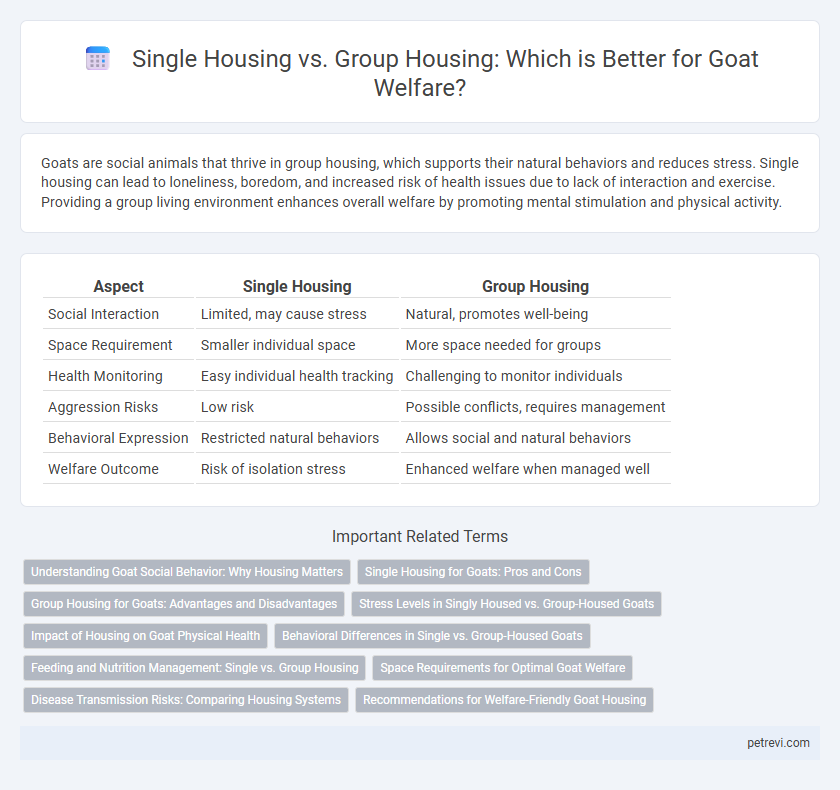Goats are social animals that thrive in group housing, which supports their natural behaviors and reduces stress. Single housing can lead to loneliness, boredom, and increased risk of health issues due to lack of interaction and exercise. Providing a group living environment enhances overall welfare by promoting mental stimulation and physical activity.
Table of Comparison
| Aspect | Single Housing | Group Housing |
|---|---|---|
| Social Interaction | Limited, may cause stress | Natural, promotes well-being |
| Space Requirement | Smaller individual space | More space needed for groups |
| Health Monitoring | Easy individual health tracking | Challenging to monitor individuals |
| Aggression Risks | Low risk | Possible conflicts, requires management |
| Behavioral Expression | Restricted natural behaviors | Allows social and natural behaviors |
| Welfare Outcome | Risk of isolation stress | Enhanced welfare when managed well |
Understanding Goat Social Behavior: Why Housing Matters
Goats exhibit strong social bonds and natural herd behavior, making group housing essential for their mental well-being and stress reduction. Single housing can lead to social isolation, increasing anxiety and abnormal behaviors such as pacing or vocalizing excessively. Proper group housing that mimics natural social structures promotes healthier interactions, improved feeding patterns, and overall better welfare outcomes for goats.
Single Housing for Goats: Pros and Cons
Single housing for goats offers advantages such as reduced aggression and easier monitoring of individual health, minimizing the spread of contagious diseases. However, isolation may lead to increased stress and behavioral issues due to goats' natural social tendencies, impacting overall welfare. Effective management requires balancing disease control with the social needs of goats to ensure optimal well-being.
Group Housing for Goats: Advantages and Disadvantages
Group housing for goats enhances social interaction, reducing stress and promoting natural behaviors essential for welfare. It increases space efficiency and allows for better management of herd dynamics but may lead to competition for resources and risk of injury if overcrowding occurs. Effective group housing requires careful design, including adequate feeding stations and space allocation to balance social benefits with health and safety concerns.
Stress Levels in Singly Housed vs. Group-Housed Goats
Goats housed individually often exhibit elevated cortisol levels, indicating increased stress compared to their group-housed counterparts, who benefit from social interactions that reduce anxiety and promote natural behaviors. Studies show that isolated housing can lead to stereotypic behaviors and heightened vigilance, while group housing supports better overall welfare by facilitating social bonding and cooperative behaviors. Managing stress through group housing aligns with ethological needs, enhancing immune function and reducing the risk of behavioral disorders in goats.
Impact of Housing on Goat Physical Health
Single housing often limits goats' ability to express natural behaviors, leading to increased stress and potential health issues such as weaker immune responses and reduced muscle tone. Group housing promotes social interaction, which supports better physical health by encouraging movement, reducing stress-related illnesses, and enhancing overall well-being. Properly managed group environments with adequate space and hygiene significantly decrease the incidence of respiratory and gastrointestinal diseases compared to isolated housing.
Behavioral Differences in Single vs. Group-Housed Goats
Group-housed goats exhibit more natural social behaviors such as grooming, play, and hierarchical interactions, which are critical for their psychological well-being. Single-housed goats may display signs of stress and abnormal behaviors including pacing and vocalizations due to social isolation. Behavioral studies indicate that group housing promotes mental stimulation and reduces stereotypic actions, enhancing overall goat welfare.
Feeding and Nutrition Management: Single vs. Group Housing
Single housing allows for precise control over individual goat feeding and nutrition management, reducing competition and ensuring each animal receives the correct diet. Group housing requires careful feeding strategies to prevent dominant goats from monopolizing resources, which can lead to uneven nutrition and stress. Effective group feeding systems include multiple feeding stations and balanced diet formulations to support herd health and welfare.
Space Requirements for Optimal Goat Welfare
Optimal goat welfare requires sufficient space to allow natural behaviors and reduce stress, with single housing typically demanding at least 1.5 square meters per goat, while group housing necessitates approximately 2.5 to 3 square meters per individual to accommodate social interactions and movement. Adequate space in group housing supports hierarchy establishment and reduces aggression, improving overall health and productivity. Failure to meet these spatial requirements can lead to increased incidences of injury, disease, and behavioral issues among goats.
Disease Transmission Risks: Comparing Housing Systems
Group housing of goats increases the risk of disease transmission due to closer contact among animals, shared feeding areas, and communal bedding, facilitating the spread of pathogens such as Paratuberculosis and Caprine Arthritis Encephalitis. Single housing reduces direct contact and limits exposure to infectious agents, but may lead to stress-related immune suppression, potentially impacting overall health. Effective biosecurity measures and regular health monitoring are critical in both systems to mitigate disease risks and promote optimal goat welfare.
Recommendations for Welfare-Friendly Goat Housing
Group housing promotes natural social behaviors and reduces stress in goats, improving overall welfare compared to single housing. Providing ample space, proper ventilation, and comfortable bedding in group pens enhances health and minimizes aggression. Recommendations emphasize maintaining stable group compositions and incorporating environmental enrichment to support goats' psychological and physical needs.
Single housing vs Group housing for Goat welfare Infographic

 petrevi.com
petrevi.com